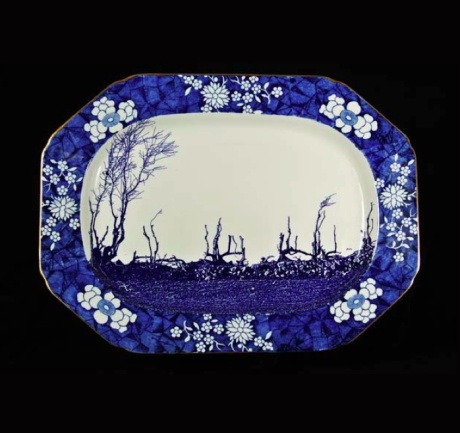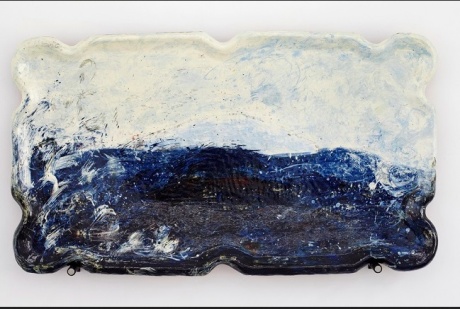Danish potter Hans Vangsø makes, among other things, plates and platters. He lives and produces work in the scandinavian tradition of bold simplicity. Pieces undergo many firings, building up a rich and wildly complex surface in the Japanese tradition: “the finished pieces have a compelling rawness and immediacy” (Lindsay Brown, Ceramic Review 266)
This image was taken from the artist’s website, Gallery April2014. The set of photos show recent production of dishes, all 20-30 cm wide and 30-40 cm high; a few 40-60 high. No titles! Hans Vangsø recently had an exhibition at Oxford Ceramics Gallery
Paul Scott is a ceramicist who has eschewed studio ceramics traditions and built his reputation on the production of printed plates: ‘In Paul Scott’s hands domestic ceramics mutate into subversive comments on our life and times. His manipulation of the established vocabularies of printed motifs and patterns, and his use of the traditional blue and white, gives his work a particular resonance that leans on our recognition of its roots”. (Dr Jo Dahn in Remember Me catalogue essay for exhibition held at the University of Wales 2001).
 Scott’s Cumbrian Blue(s) Hedgerow No:6, In glaze decal collage and gold lustre on old earthenware plate (c.1930) marked Copeland Late Spode. 38 x 28 cms. Image from Scottish Gallery 2012 exhibition ‘Blue and White Horizons’
Scott’s Cumbrian Blue(s) Hedgerow No:6, In glaze decal collage and gold lustre on old earthenware plate (c.1930) marked Copeland Late Spode. 38 x 28 cms. Image from Scottish Gallery 2012 exhibition ‘Blue and White Horizons’
Marit Tingleff is the Norwegian ceramicist who really fired me up to start this project. Her vast earthenware pieces are given the form of dishes but the intensity, tension and depth of surface works like a painting. The pieces are both weighty and delicate, almost dream like with suggestions of remembered landscape.
 Marit Tingleff, Panorama 1, earthenware painted with colored slips, transparent glaze, 168 w x 90 h centimeters. Photograph by Thomas Tveter. Image courtesy of the artist. This piece was exhibited at Copenhagen Ceramics. in 2012
Marit Tingleff, Panorama 1, earthenware painted with colored slips, transparent glaze, 168 w x 90 h centimeters. Photograph by Thomas Tveter. Image courtesy of the artist. This piece was exhibited at Copenhagen Ceramics. in 2012
The three platters here each represent a form of romantic landscape, traditionally a subject for plates. The size of Marit Tingleff’s platter defies the possibility of function; Paul Scott’s plate is a comment on the vulnerability of landscape and Hans Vangsø responds to his landscape in a joyful way.The formal qualities of these three platters are constant – a central area with a rim, visual interest in the design or surface, light reflecting from the surface which reinforces the 3 dimensional qualities. They all address the concerns of painters – searching for a way to interpret the world – and all have the physicality of a pot. But all three, it appears, are made with the intention of being seen on the wall, or at least displayed vertically. They each take into account the world beyond themselves – the space where they are, light, function.
